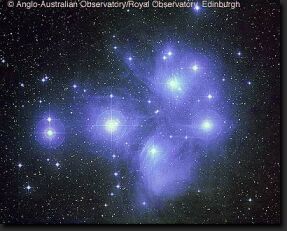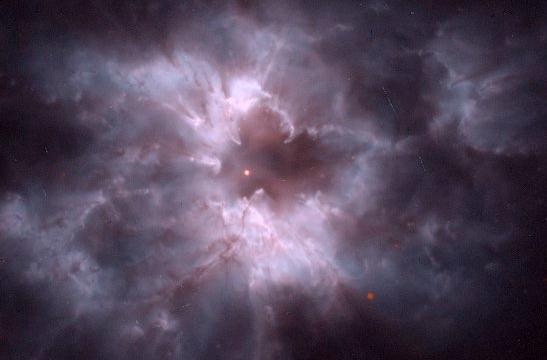Regulus 4?

Regulus 4? |

|
|
| Home | Stars | Habitability | Life | |
 ©
AAO/ROE, photo by
David Malin
©
AAO/ROE, photo by
David Malin
(Used with permission)
Larger labelled image of the
Pleiades,
or a color photo of
Regulus
A by
John Chumack.
Regulus A is a blue-white star that
is larger, brighter, and hotter than
Sirius A, like six of the brightest
stars of the
Pleiades
Cluster at left.
(See
Sloan Digital Sky Survey
field images of
Regulus
from
WikiSky.org.)
System Summary
In June 2008, a team of astronomers presented evidence in a pre-print that the primary star has a single-line spectroscopic companion, which is most likely a white dwarf with at least 0.3 Solar-masses at an average orbital separation of around 0.35 AUs (Gies et al, 2008). Before the close companion became a white dwarf stellar remnant, it would have contributed around 15 percent of its mass to the current primary star, which sped it up to its current rotational period of only 15.9 hours. If the hypothesis is correct, then the entire system may be at least a billion years old (Rappaport et al, 2009).

H. Bond (STSci),
R. Ciardullo (PSU), WFPC2, HST, NASA
(Regulus may have a close white dwarf companion -- like
NGC
2440, above -- which
may have contributed mass that also increased the spin of Star A)
System Summary
The Regulus, or Alpha Leonis, multiple star system is located around 77.5 light-years (ly) from Sol (HIPPARCOS Plx of 42.09, +/- e_Plx of 0.79 mas). The star lies in the eastern part (10:8:22.3+11:58:1.9 for Star A, 10:8:12.8+11:59:48.4 for Star B, and 10:8:14+11:59.8 for Star C, ICRS 2000.0) of Constellation Leo (see chart and photo), the Lion -- north of Constellation Sextans. In the venerable Star Names: Their Lore and Meaning, Richard Hinckley Allen noted that its proper name, Regulus, is the diminutive form of the Latin "Rex" (King), in turn derived from the Greek for "Star of the King" and the much earlier Akkadians of Mesopotamia as the legendary "King of the Celestial Sphere" who ruled before the Great Flood. According to Professor Jim Kaler's Stars page on Regulus, Star A is one of the dimmest of the first magnitude stars (see a color photo of Regulus A). It lies only half a degree from the ecliptic on the path of the Sun and so is regularly occulted by the Moon. In addition to wide binary stellar companions (stars B and C), Regulus also has a well known optical companion (Wo or GJ 9316 D).
Regulus is a blue-white main sequence star of spectral and luminosity type B7-8 Va,ne (NASA Stars and Exoplanet Database; Gray et al, 2003; and Mahipal Singh, 1982). The star may have a mass 3.4 times greater than Sol's, 3.14 times its diameter between the poles and 4.16 at the equator (Kenneth Croswell, 2005; McAlister et al, 2005); Henson, et al, 1989; and angular diameter in two colors from a Lunar occultation from Richard R. Radick, 1982), and 140 times its visual luminosity (240 times with ultraviolet). Originally thought to be around 300 million years old, the age of all three stars has recently been revised to around 50 million years old (Kenneth Croswell, 2005; McAlister et al, 2005; and Gerbaldi et al, 2001).

NASA
Observatorium
Regulus A is hotter,
brighter, and bluer
than
Vega or
Sirius A,
but is cooler, dimmer,
and smaller than
Spica.
See a discussion of
the
"main
sequence"
as part of
stellar
evolution and death.
As a very young star, Regulus A appears to be a fast rotator with a rotational period of 15.9 hours and a substantial magnetic field around one kG (Kenneth Croswell, 2005; McAlister et al, 2005; Henson, et al, 1989; and Wolstencroft et al, 1981). Due to its fast rotation, the star is somewhat "pumpkin-shaped" (Kenneth Croswell, 2005), as interferometric observations and spectroscopic data suggest that indicate Star A's diameter is about 32 percent greater at the equator than between its poles (McAlister et al, 2005). According to the Yale Bright Star Catalogue, 1991 5th Revised Edition notes entry for HR 3982, excess infrared emission indicative of dust has been detected. Regulus A is a variable star designated CSV 101099 and NSV 4750. Useful catalogue numbers and designations for the star include: Alp or Alf Leo A, 32 Leo A, HR 3982, GJ 9316 A, Hip 49669, HD 87901, BD+12 2149, SAO 98967, FK5 380, Wo 9316 A, LTT 12716, and ADS 7654 A.
According to Robert Burnham, Jr. (1931-93), Regulus A has relatively distant, orange-red and red dwarf binary companions BC that were last observed to be separated by around 4,200 AUs. Their wide separation implies an orbital period of at least 130,000 years, according to Professor Jim Kaler's Stars page on Regulus. The Astronomiches Rechen-Institut at Heidelberg's ARICNS entry for Star B notes that the observed separation between Star A and its binary companions has been 177" at 307° from 1836 to 1960. (A review of young B-type stars with wide binaries is available from: Robert E. Murphy, 1969, pp. 1086-1087).
In June 2008, a team of astronomers presented evidence in a pre-print that the primary star has a single-line spectroscopic companion "Ab," which is most likely a white dwarf with at least 0.3 Solar-masses at an average orbital separation of around 0.35 AUs (Gies et al, 2008). Before the close companion became a white dwarf stellar remnant, it would have contributed around 15 percent of its mass to the current primary star, which sped it up to its current rotational period of only 40.1 days. Star Ab may have originally had around 2.1 Solar-masses. If the hypothesis is correct, then the entire system may be at least a billion years old (Rappaport et al, 2009).

H. Bond (STSci),
R. Ciardullo (PSU), WFPC2, HST, NASA
(Regulus may have a close white dwarf companion -- like
NGC
2440, above -- which
may have contributed mass that also increased the spin of Star A)
Star "B" is a orange-red main sequence dwarf star of spectral and luminosity type K1-2 V (McAlister et al, 2005; and Gies et al, 2008). It may have around 80 percent of Sol's mass, somewhat less than its diameter, and 31 percent of its luminosity.

© Torben Krogh & Mogens Winther,
(Amtsgymnasiet
and EUC Syd Gallery,
student photo used with permission)
Regulus B is an orange-red dwarf
star, like Epsilon Eridani at left
center of the meteor.
According to Robert Burnham, Jr. (1931-93), stars B and C have a combined visual luminosity of around 31 percent of Sol's. The most recently observation reported implied a separation around 98.9 AUs (4.163" at 77.5 ly) with a period around 2,000 years, based on the Yale Bright Star Catalogue, 1991 5th Revised Edition notes entry for HR 3982*. According to the Astronomiches Rechen-Institut at Heidelberg's ARICNS entry on Star C, the separation of stars B and C has varied between 3.9" at 93° in 1867 to 2.5" at 86° in 1943.

NASA -- larger image
Regulus C is a dim red dwarf star, like
Gliese 623 A (M2.5 V) and B (M5.8Ve) at lower right.
Star "C" is a red main sequence dwarf star of spectral and luminosity type M4-5 V (McAlister et al, 2005; and Gies et al, 2008). It may have a fifth of Sol's mass, substantially less than its diameter, and 0.31 percent of its luminosity. The orbit of an Earth-like planet (with liquid water) around Star C would be centered around 0.056 AU -- well inside the orbit of Mercury in the Solar System -- with an orbital period of 10.7 days. Useful catalogue numbers and designations for the star include: Alp or Alf Leo C, 32 Leo C, GJ 9316 C, Wo 9316 C, and ADS 7654 C.
Closest Neighbors
The following table includes all star systems known to be located within 10 light-years (ly), plus more bright stars within 10 to 20 ly, of Regulus.
| Star System | Spectra & Luminosity | Distance (light-years) |
| Steph 852 | M0 V | 6.6 |
| LTT 12663 | M V | 7.9 |
| LTT 12680 | DC7 /VII | 8.2 |
| Steph 823 | M0 V | 8.6 |
| LTT 12694 | M0 V | 9.8 |
| * plus bright stars * | . . . | |
| BD+12 2700 | G5 V | 11 |
| 40 Leonis | F6 IV | 13 |
| 39 Leonis AB | F8 Vbw M1 V | 15 |
| BD+16 2116 AB | G2-5 V ? | 17 |
Other Information
Try Professor Jim Kaler's Stars site for other information about Regulus at the University of Illinois' Department of Astronomy.
Up-to-date technical summaries on this star can be found at: the Astronomiches Rechen-Institut at Heidelberg's ARICNS for Star A Star B, and Star C; and the NASA Stars and Exoplanet Database. Additional information may be available at Roger Wilcox's Internet Stellar Database.
Constellation Leo represents the Lion that Hercules (also a constellation) had to kill as one of his 12 tasks. For more information and an illustration of the constellation, go to Christine Kronberg's Leo. For another illustration, see David Haworth's Leo.
For more information about stars including spectral and luminosity class codes, go to ChView's webpage on The Stars of the Milky Way.
© 1998-2009
Note: Thanks to
David Bellomy
for notifying us of Star A revised status as a spectroscopic binary with
a possible white dwarf companion.
Sol Company. All Rights Reserved. |